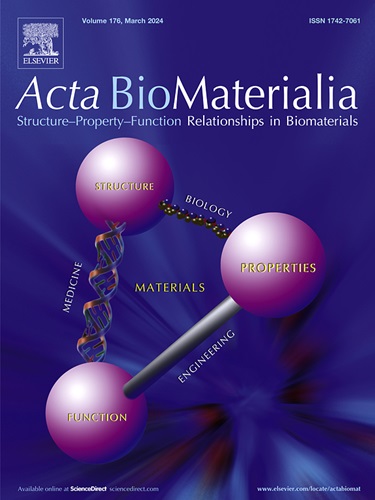Biodegradable Magnesium alloy Janus membrane with surface-selective osteoinduction and soft tissue healing properties in guided bone regeneration
IF 9.4
1区 医学
Q1 ENGINEERING, BIOMEDICAL
引用次数: 0
Abstract
Given that the guided bone regeneration (GBR) membrane acts at the interface between the bone and connective tissue, the membrane imposes high demands on the organization of the material. Magnesium (Mg) alloys have emerged as promising candidates for GBR due to their biodegradability and favorable biocompatibility. However, challenges remain in the risk of soft tissue dehiscence and limited osteogenesis for Mg membranes in the clinical application. A dicalcium phosphate dihydrate (CaHPO4·2H2O, denoted as DCPD)/MgF2 Janus membrane was fabricated via chemical conversion and deposition, showcasing suitable degradability, surface-selective osteogenic property and soft tissue healing in vitro and vivo. The DCPD coating was designed to support osteogenesis, while the MgF2 coating was specifically engineered to facilitate soft tissue healing. Furthermore, the Janus membrane utilized its two-sided properties to show selectivity in adhesion, proliferation, and migration of the MC3T3-E1 and HGFs. In vivo results exhibited its capability to promote bone formation and optimal space maintenance ability. Notably, further RNA-seq analysis demonstrated that different functional cells may respond specifically to two coatings and exert functions. Taken together, these results provide an alternative method for designing surface-selective biomaterials, underlining effective potential applications in bone tissue engineering.
Statement of significance
Traditional clinical treatment of bone defects with GBR membranes is frequently constrained to a single superimposed osteogenesis without structural-functional integration. Such a DCPD/MgF2 coated Janus membrane was fabricated by incorporating chemical deposition and transformation to satisfy optimal osteogenesis and soft tissue healing. Of particular interest, the Janus membrane allowed for chemotactic movement with specific cellular responses to stimuli from different coatings. In vivo, the membrane demonstrated promising effects and showcased space maintenance ability. The design concept exhibits a new avenue to regulate tissue regeneration between different tissue interface, presenting new horizons for the development of GBR membranes.

求助全文
约1分钟内获得全文
求助全文
来源期刊

Acta Biomaterialia
工程技术-材料科学:生物材料
CiteScore
16.80
自引率
3.10%
发文量
776
审稿时长
30 days
期刊介绍:
Acta Biomaterialia is a monthly peer-reviewed scientific journal published by Elsevier. The journal was established in January 2005. The editor-in-chief is W.R. Wagner (University of Pittsburgh). The journal covers research in biomaterials science, including the interrelationship of biomaterial structure and function from macroscale to nanoscale. Topical coverage includes biomedical and biocompatible materials.
 求助内容:
求助内容: 应助结果提醒方式:
应助结果提醒方式:


